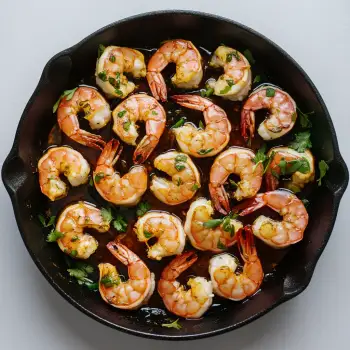
 1025 minutes
1025 minutesA rustic artisanal bread loaf made using a combination of beer and vinegar to enhance flavor and texture.


teaspoons
Instant Yeast
teaspoons
Water, room temperature
cups
Mild-Flavored Lager, room temperature
tablespoons
tablespoons
1. Prepare dough
Whisk together the flour, salt, and yeast in a large bowl. Add the water, beer, and vinegar, then use a rubber spatula to fold the mixture until a shaggy ball forms, making sure to scrape any dry flour from the sides of the bowl. Cover the bowl with plastic wrap and let the dough rest at room temperature for 8 to 18 hours.
2. Knead and shape dough
Prepare a 10-inch skillet by lining it with parchment paper and spraying it with vegetable oil. Transfer the dough to a lightly floured counter and knead it by hand 10 to 15 times. Shape the dough into a ball by pulling the edges into the middle, then place it seam side down in the prepared skillet. Lightly spray the surface of the dough with oil spray, cover loosely with plastic wrap, and let it rise at room temperature for about 2 hours, or until it has doubled in size.
3. Preheat oven and Dutch oven
Preheat your oven to 500 degrees, placing a Dutch oven with its lid on the lowest rack to heat for 30 minutes.
4. Slash and bake dough
When the dough has finished rising, lightly flour the top and make two 6-inch-long, ½-inch-deep slashes in the shape of an X. Carefully remove the hot Dutch oven from the oven, lift the dough using the parchment overhang, and lower it into the pot. Cover the pot and place it in the oven, then reduce the temperature to 425 degrees. Bake the loaf covered for 30 minutes, then uncover and continue baking for another 20 to 30 minutes, until the crust is a deep golden brown and the loaf registers 210 degrees internally.
5. Cool and store loaf
Once baked, remove the loaf from the pot and transfer it to a wire rack. Discard the parchment paper and let the bread cool to room temperature for about 2 hours before slicing. If needed, you can store the loaf wrapped in a double layer of plastic wrap at room temperature for up to 2 days, and recrisp it in a 450-degree oven before serving.
Add chopped olives and sun-dried tomatoes to the dough for a Mediterranean twist. This combination works wonderfully with a sprinkle of herbs like basil or oregano.
If you have a sourdough starter, you can use it in place of commercial yeast to create a sourdough version of this artisanal loaf. This will give the bread a tangier flavor and a chewier texture.
Incorporate whole wheat flour, rye flour, or a combination of different flours to add nutritional value and a new dimension of flavor. You can also add seeds like sunflower, pumpkin, sesame, or flax for texture and taste.
Fold in grated cheese such as cheddar, Gruyère, or Parmesan during the final mixing stage for a cheesy loaf. You can also top the bread with additional cheese before baking for a crispy, cheesy crust.
Add olives, roasted garlic, sun-dried tomatoes, nuts, seeds, or cheese to the dough for additional flavors. For a crunchy crust, sprinkle with oats, cornmeal, or a mix of seeds (such as sesame, poppy, or sunflower) right before baking. These inclusions can dramatically change the flavor profile while keeping the bread recognizable.
Let the loaf cool on a wire rack for at least an hour before slicing to prevent a gummy texture.
Ensure the lager is at room temperature to activate the yeast effectively.
Develop gluten until the dough passes the windowpane test for optimal structure.
Opt for a craft lager with a rich profile—caramel or nutty notes complement the vinegar.
Allow the dough to rise 1.5 times its size and show surface bubbles for flavor and texture development.




Comments (0)